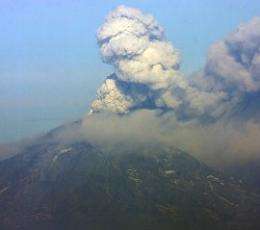Mt. Redoubt Gives Alaskans a Taste of the Moon

"It's very fine but angular - the sharp edges make it feel gritty and abrasive."
"It can cause short circuits and failure of electronic components ... and physical damage to equipment."
"It's much more abrasive than sand....scratches anything that comes in contact...."
"...a real nuisance....stuck to everything - equipment, instruments,...likely to penetrate seals,....plugs bolt holes, fouls tools, ....."
These quotes seem to all refer to the same annoying substances, but they don't. In fact, the substances they refer to aren't even from the same planet.
The first two quotes are from Alaska, where people are dealing with volcanic ash from the ongoing eruption of Mount Redoubt. The next two come from the Moon, where Apollo astronauts once dealt with a similar problem: moondust.
"Volcanic ash and moondust have a lot in common," says Carole McLemore* of the Marshall Space Flight Center. "Both coat things and stick to them, are grimy, abrasive, damaging to equipment and vehicles, susceptible to electric charging, and risky to inhale.
"Mount Redoubt is giving Alaskans a taste of life on the Moon!"
The stories Alaskans and astronauts tell reveal some of the parallels:
Charles Sloan, a retired hydrogeologist living in Anchorage, has experienced ash first hand. He was around for one of Mount Redoubt's previous eruptions in 1989 and remembers a particularly harrowing incident.
"An international carrier flight -- a large jet -- flew into the hot ash plume from the volcano. The ash was sucked into the engines, causing them to shut down, and the plane plummeted!" All 245 terrified passengers on board KLM flight 867 held their breaths. "The plane dropped more than 2 miles before the crew could get the engines restarted! It limped in to an emergency landing in Anchorage."
"That was the third such incident over a five year period," adds Tom Miller, former director and now scientist emeritus of the Alaska Volcano Observatory** in Anchorage.
Way back in 1972, astronauts Gene Cernan and Jack Schmitt experienced their own transportation problems when their moonbuggy lost a fender. That doesn't sound like a disaster on the scale of a plummeting airplane—but when moondust is involved, even a lost fender can have serious consequences.
A rolling moonbuggy without a fender kicks up a "rooster tail" of moondust, spraying the rover and its occupants with dark, abrasive grit. White spacesuits blackened by dust turn into absorbers of the fierce lunar sun with astronauts overheating dangerously inside. Sharp-edged dust wiped off visors scratch the glass, making helmets difficult to see out of. Watch out for that crater! And moondust has an uncanny way of working itself into hinges, latches and joints, rendering them useless.
The resourceful astronauts repaired the fender with duct tape, but even with all four fenders, Cernan had to dust off the rover at each stop. Getting rid of moondust remained a top priority.
Back in Alaska, Miller relates what happened when Mt. Redoubt erupted just last week: "We lost three seismic stations. The one nearest the volcano was fried - probably due to lightning. When you have a tremendous and powerful explosion of ash, the violent movement of all the ash particles generates static electricity and therefore lightning."
Dust particles on the Moon are also electrified, at least in part, by the buffeting of the solar wind. Earth is protected from the solar wind by our planet's magnetic field, but the Moon has no global magnetic field to ward off charged particles from the sun. Free electrons in the solar wind interact with grains of moondust and, in effect, "charge them up." The electrostatic charges cause moondust to cling tenaciously to everything.
Including your lungs…
Apollo 17 astronaut Gene Cernan suffered from the first recorded case of extraterrestrial hay fever. He was taking off his spacesuit after a moonwalk and the air was filling up with dust knocked off the surface of the suit. "It came on pretty fast," he radioed Houston with a stuffy-nose twang. "I had a significant reaction to the dust," he later recalled. "My turbinates (cartilage plates in the walls of the nasal chambers) became swollen."
Some researchers believe sustained breathing of moondust could be dangerous. The sharp-edged grains are able to make tiny cuts in flesh, and they could easily become stuck in lung tissue. Ash presents a similar hazard.
"With volcanic ash, people are advised to wear particle masks or stay indoors," notes Miller. "It's not poisonous, but people with asthma or emphysema can have problems if they inhale it. And people who wear contacts have to take their contacts out."
Alaska resident Michelle Cosper is one of the people suffering. "My throat is sore and stingy, and it smells vaguely like sulfur outside," she reports from the town of Girdwood, which has received a coating of ash from Redoubt's recent eruptions. "We aren't supposed to walk our dogs or go outside for any other reason unnecessarily. Even local newscasters are wearing face masks."
Moondust and volcanic ash cause many of the same troubles—but that does not mean they are the same thing. Volcanic ash comes from active volcanoes, something the Moon does not have. Liquid rock decompresses and explodes from the volcano's mouth, producing a mixture of 'foamed' glass and micro- and mini-crystals. Moondust, on the other hand, is created by meteoroids. Space rocks hit the Moon's surface at hundreds of thousands of miles per hour, fusing topsoil into glass and shattering the same into tiny sharp-edged pieces.
NASA is returning to the Moon in ~2020. Thanks to Mt. Redoubt, Alaskans are already getting a taste of the new frontier.
Source: Science@NASA



















